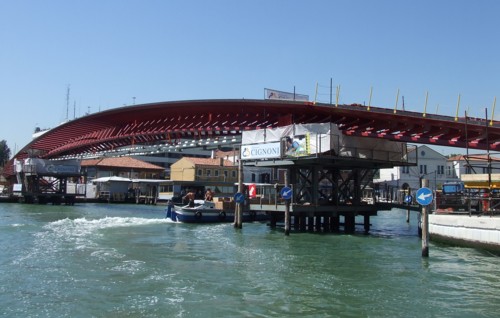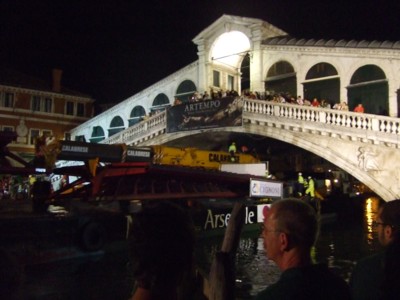Until the nineteenth century, there was only one bridge over the Grand Canal: the Rialto. Efficiency drives then saw the erection of two more bridges (replaced in the 1930s) at useful crossing places. The Ponte degli Scalzi at the northern end of the Grand Canal serves the town’s road terminus and railway station, and the Accademia crosses the canal’s southern bend.
Way back in the 1990s it was decided to give the town a new, fourth crossing. The project was designed by Spanish architect Santiago Calatrava, and until its official name was finally determined – Ponte della Costituzione – the bridge took his name, and it is still widely known as the Ponte di Calatrava. It is a long sweeping form of glass and steel accessed by steps.
Controversy and stages of development
It was a controversial project from the start; criticised as an expensive and unnecessary vanity project. As the project’s timescale stretched and it went overbudget, residents’ grumbles grew louder. Many felt there were better areas to spend public funds on, such as housing. Some disliked the modern styling, finding it too anachronistic. Public relations hit a low point when it was revealed that there was no provision for disabled access (the council had to promise to add ‘pod’ lifts). However, there is also a part of the population that welcomes innovation in principle, laments the absence of modern architecture in the city, and feels civic pride in this new landmark.
There were times when it seemed unlikely that the bridge would ever be finished, but a flurry of activity in summer 2007 saw the bridge components make an appearance in Venice. To reach the bridge site from their starting point on the mainland, they had to traverse the whole length of the Grand Canal – a nervous business, with tight bends and three historic bridges to negotiate. The canal was closed overnight, and locals took their places to watch history. As the barges squeezed under the Rialto ahead of schedule, with startling efficiency, some applauded, some sang the Venetian anthem, and others held protest banners aloft.

Strange location?
In the long stretches of the Grand Canal without a bridge, residents cross the canal using a traghetto (gondola-ferry) or by taking the vaporetto from one stop to the next. The site of the new bridge, however, is not in one of these busy crossing places. It is only a short distance from an existing bridge, the Ponte degli Scalzi, and it’s hard to see what additional benefit it could bring, apart from saving a few minutes’ walk. It doesn’t, for example, have ramps to help either the disabled or travellers with suitcases. The new bridge links the bus terminal at Piazzale Roma with some empty buildings alongside the railway station. So the bridge could be seen as a transport interchange – if it weren’t for the fact that there is no reason to transfer from bus to train in Venice. Both buses and trains head in one direction only: back over their parallel bridges to the mainland, where there is already an interchange at Mestre station.

The latest
In August 2007 the central section of the new bridge was ferried down the Grand Canal, and put in place. Around the same time there were reports that Santiago Calatrava had suggested adding bronze sculptures to the bridge. We’ve heard no more of this; Venetians were doubtless sighing and tightening their grip on their public purse. After the prompt installation of the main components though, the opening of the brige was delayed repeatedly. When it finally opened, there were immediate complaints. Apart from the lack of ramped access for wheelchairs and suitcases, the bridge’s design is very flawed. As large sections are made of glass, on a rainy day all the users, fearing slippery surfaces, file down the central, non-glass section. The small steps are irregular and not clearly marked, while the glass parapets have treacherous gutters edging the walkway; minor accidents are frequent. Remarkably, on one occasion an enterprising group of young people, who’d been drinking, managed to drive a car over the bridge and down one of Venice’s pedestrian thoroughfares. The bridge is now securely guarded by concrete flower tubs. After several years, the long-promised ‘pods’ for wheelchair travellers finally took shape. My recollection is that they did work a few times before the project was classed as failed. Now there are porters waiting to help with luggage.
> See our blog entry and brief video of the side sections being transported under the Rialto.
On this site
Useful external links
Venice council (with project notes)